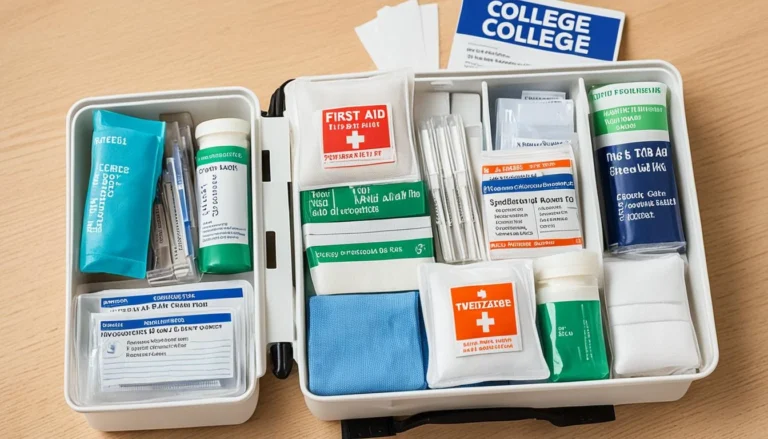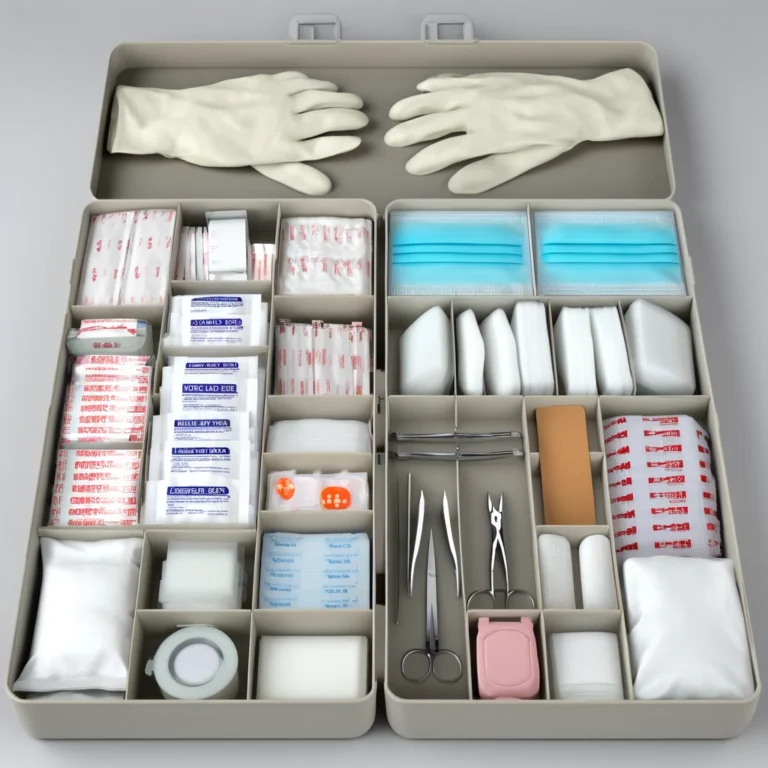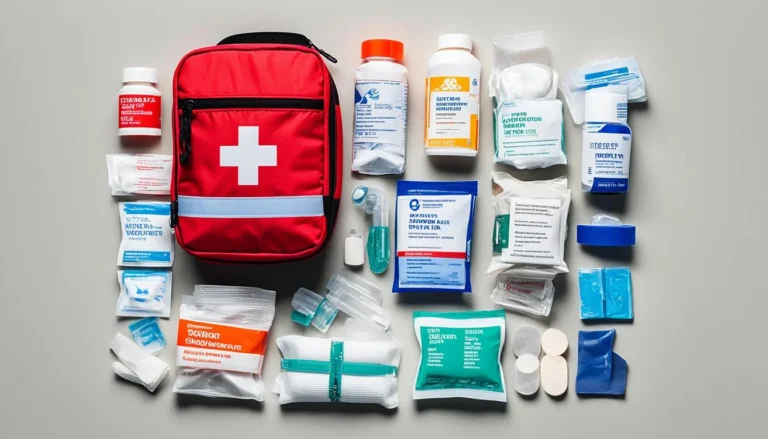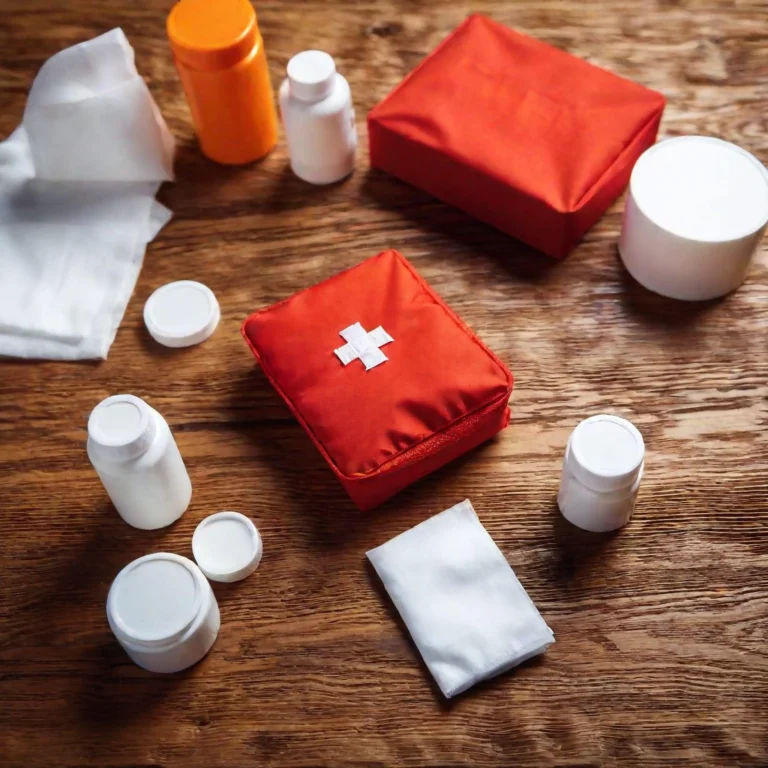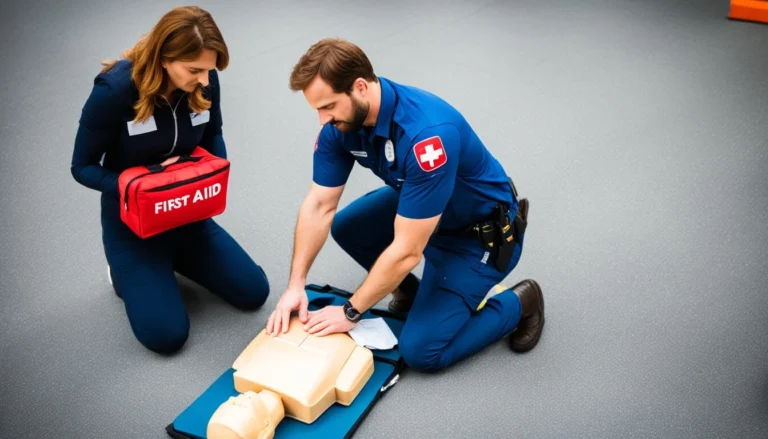First Aid Kits in Commercial Vehicles: Mandatory?
Yes, first aid kits are required in commercial vehicles in the UK. The Health and Safety (First-Aid) Regulations 1981 require employers to provide adequate and appropriate equipment, facilities, and personnel to ensure their employees receive immediate attention if they are injured or taken ill at work.
In the UK, there’s a rule from 1981 that talks about safety at work. It says bosses must have the right first-aid stuff. This includes commercial vehicles too. This makes first aid kits very important, not just extra items. An employer must check what their moving staff needs. While there’s a guide for what a first aid kit should have, it’s not a must by law.

Key Takeaways
- Commercial vehicles are very important in the UK, with safety being a top priority.
- Bosses have to follow the Health and Safety (First-Aid) Regulations 1981 for vehicle first aid kits.
- Choosing first aid items for vehicles is based on careful thought, not just a list.
- BS 8599-2 gives advice on what should be in vehicle first aid kits, but it’s not required by law.
- It’s key to know what the law says and what is good practice for vehicle safety in the UK.
The Legalities of First Aid Kits in Commercial Vehicles
Is it a must to have a first aid kit in commercial vehicles under UK law? Yes, for vehicles used for business, this is very important. This is because it’s not just about following rules. It’s about keeping people safe.
Employers need to check their work carefully to see if they need first aid kits. They do this by looking at what could go wrong. This is important in many situations. Like in big trucks or in cars used for work.
- Figuring out risks in different driving jobs.
- Thinking about what could go wrong while driving.
- Choosing the right first aid equipment after knowing the risks.
The Health and Safety Executive (HSE) gives advice on this. They say it’s key to pick what goes into the kit based on the job. It means not every vehicle needs the same things.
There’s no set list of what must be in the kit. Employers have to think about many things. Like how big the vehicle is, how many people are in it, and where it’s going.
So, having a first aid kit in work vehicles is about safety, not just law. It’s up to employers to make sure everyone is safe. This includes the drivers, passengers, and everyone else too.
Understanding the Health and Safety (First-Aid) Regulations 1981
Employers in the UK must know their duties under the Health and Safety (First-Aid) Regulations 1981. They must make sure that mobile employees have first aid resources for emergencies. This is very important when they are working away.
Employer Responsibilities for First Aid in the Workplace
Employers should check what first aid items they need. This is to keep their staff safe and well. It’s for all workers, even those who travel for work.
They need to be ready for different risks. This includes places outside the business site. Places like vehicles or remote areas are included.
Assessment and Provision of First Aid Equipment for Mobile Staff
Mobile employees need special care. It’s important they have first aid items while working away. Employers must think about travel distance, place, and work type.
The BS 8599-2 offers help on what to put in kits. It’s for different vehicles and the number of people in them. This guide is useful but not a must-follow rule.
Being ready is key. Here’s what an assessment might look like, in a simple table:
| Type of Vehicle | Number of Occupants | Required First Aid Kit Size | Additional Considerations |
|---|---|---|---|
| Company Car | 1-4 | Small Kit | Extra travel-specific medications |
| Goods Vehicle | 1-2 | Medium Kit | Heavy duty bandages |
| Minibus | 5-16 | Large Kit | Multiple pairs of gloves |
| Coach | 17+ | Multiple Small Kits | Evacuation aid considerations |
Following these steps makes a safer workplace. Employees will know their health and safety matter, no matter where they work.
Are First Aid Kits Required In Commercial Vehicles
In the UK, private car owners don’t have to carry first aid kits. Yet, for commercial vehicles, it’s different. Having first aid kits is seen as key. They help with driver first aid needs. Even if not required by law, they are still important for safety.
Talking about commercial vehicle safety, it’s advised to always have a first aid kit on board. This is both a best practice and a way to be ready for emergencies. It helps keep workers safe.
| Assessment Criteria | Contents Recommendation | Special Considerations |
|---|---|---|
| Vehicle Size/Type | Basic kits for small vehicles; comprehensive kits for larger vehicles or high-risk settings. | Additional burn care supplies in hazardous material transport vehicles. |
| Passenger Capacity | Enhanced quantities for vehicles with greater passenger numbers. | Paediatric supplies for school buses or child transport services. |
| Remote Area Operation | Extended care items such as emergency blankets and signalling devices. | GPS locators or emergency communication devices for desert or offshore locations. |
| Driver/Employee Specific Needs | Personalised kits that cater to known medical conditions or allergies. | Defibrillators in vehicles used for transporting elderly or high-risk individuals. |
People in the UK believe being ready is vital, especially at work. Driving jobs pose risks. Employers should assess these risks and provide the right tools for emergencies. Not doing so could hurt both people and the company’s safety image.
Both self-employed and businesses must understand the need for first aid in vehicles. By following UK driving laws and updating first aid kits, safety in commercial vehicles improves. This shows care for workers’ health.
Although not strictly required by law, addressing driver first aid needs is vital. A good first aid kit demonstrates a commitment to safety. It means looking after each other beyond just following rules.
Analysing the BS 8599-2 Specification for Motor Vehicle First Aid Kits
The BS 8599-2 specification gives detailed first aid kit guidance for vehicles. It sets a high standard for motor vehicle first aid. Employers can follow it to be well prepared.
Looking into the BS 8599-2 helps employers. They learn what first aid they need for their vehicles. It helps them meet British Standards compliance, even though it’s not a law.
The Role of British Standards in First Aid Compliance
The BS 8599-2 sets clear rules for vehicle first aid kits. Organisations use it to make sure they meet high care standards. It shows they are ready to help in an emergency.
No Mandatory Requirement for BS Compliant Kits, but Guidance is Available
There’s no law that says you must use BS 8599-2 kits. But, the guidance it gives is very useful. Employers can show they care about safety by using it.
In the end, the BS 8599-2 specification is great for employers who want to be safer. Using it shows they care about everyone’s well-being. It’s a good choice, even if not required.
Road Casualties in the UK: The Critical Need for First Aid Kits
Road accidents in the UK show we need first aid kits in cars now. In 2022, the UK annual road accident statistics noted 135,480 road casualties. Sadly, 1711 of these resulted in death. This shows first aid kits are a must to help with injuries.
Road injuries can change lives. Having first aid close by can save lives. These kits also comfort those hurt or stressed by an accident.
| Year | Road Casualties | Fatalities | Serious Injuries |
|---|---|---|---|
| 2022 | 135,480 | 1,711 | Data Pending |
| 2021 | 131,220 | 1,460 | 23,140 |
| 2020 | 115,333 | 1,516 | 21,766 |
Stats show a strong need for first aid kits in cars. They are key to helping others after an accident. Everyone must be ready to give first care.
Being prepared for the first few critical minutes after a road accident can dramatically change the outcome for the injured.
A first aid kit is a light of hope in emergencies. With ongoing road injuries, we must focus on being prepared. Safety is vital for everyone on UK roads.
Vital Components of a Vehicle First Aid Kit
It’s key to have your vehicle emergency preparedness in check. A good first aid kit is a must. It helps a lot before experts come. Make sure your first aid kit has what you need.

All UK vehicles need a basic first aid supplies set. Public vehicles like taxis and minibuses really need them. They help a lot during emergencies.
| First Aid Supply | Minimal Recommended Quantity | Usage |
|---|---|---|
| Antiseptic wipes | 10 | For cleaning wounds before dressing |
| Sterile bandages | Assorted sizes, 4-6 | To support injured limbs or to secure dressings |
| Sterile dressings | 2 medium, 2 large | For direct application to wounds to control bleeding and prevent infection |
| Scissors | 1 pair | For cutting bandages or clothing |
| Safety pins | Minimum of 6 | For securing bandages |
| Eye pads | 2 | To cover and protect eye injuries |
Keep essential first aid kit items in a clear, reachable box. This is vital for all, especially public vehicles. Having first aid supplies ready can change things during an incident on the road.
The Necessity of First Aid Kits for Company Car Drivers and Self-Employed Workers
Many jobs today need people to move around a lot. This means we must keep them safe on the road. Having a company car first aid kit is very important. We trust these drivers a great deal. So, we must give them what they need to stay safe. Safety for self-employed driver and first aid training for employees is a must.
First Aid Preparedness for Lone Workers and Specialised Roles
Some workers, like those in health care or delivery, often work alone. They might not get help quickly if needed. Having a special lone worker first aid kit can help a lot. This makes sure they can take care of themselves until help arrives. Employers need to understand where their workers will be. This makes sure the first aid kit has the right things in it.
The Importance of First Aid Training for Mobile Employees
It’s not enough to just have first aid kits. Knowing how to use them is very important, too. This is why first aid training for employees is key. This training means workers can help themselves and others well. It shows that knowing what to do is as important as having the tools.
| Aspect of Safety | Relevance to Company Car Drivers | Relevance to Self-Employed Workers |
|---|---|---|
| First Aid Kit Availability | Ensure kits are adapted to driving patterns and car usage | Customise kits according to job specificity and individual needs |
| Risk Assessment Alignment | Adhere to company safety policies and risk assessments | Conduct personal risk assessments; update kits as necessary |
| First Aid Competency | Engage with company-provided training; periodic refresher courses | Seek accredited courses to meet British Standard Workplace First Aid Kits recommendations |
| Emergency Response Readiness | Be prepared for any on-road incidents, advocating prompt and effective action | Independently handle situations that arise in transit, minimizing impact until professional help arrives |
Having company car first aid kits and well-trained workers makes everyone safer. This helps not just those on the road, but everyone. It makes our travels safer. This approach helps everyone, making our roads safer for all.
First Aid Requirements for Public Service Vehicles: What You Must Know
Keeping passengers safe in public vehicles is very important. UK laws are strict about first aid in taxis, minibuses, and coaches. Operators must know and follow these rules. This means knowing the specific mandatory kit contents needed. Following the compliance regulations for taxis and coaches means help can be given quickly in emergencies. This is critical for helping anyone who is ill or hurt.
List of Mandatory First Aid Contents for PSVs
The UK has set rules for what must be in PSV first aid kits. Each kit should have everything needed for first aid. The required items cover different emergencies that could happen while travelling. Now, let’s look at what these items are:
| Item | Quantity | Purpose |
|---|---|---|
| Sterile Wipes | 10 | For cleaning wounds without alcohol to prevent irritation |
| Adhesive Dressings | 20 | Essential for small cuts or abrasions |
| Sterile Eye Pads | 2 | To cover and protect eye injuries |
| Triangular Bandages | 4 | For immobilising limbs and as slings |
| Medium Sterile Dressings | 6 | To dress moderate wounds and promote healing |
| Scissors | 1 | For cutting bandages or clothing away from injuries |
| Safety Pins | 12 | To secure bandages in place |
Public Service Regulation Compliance Checklist
Taxi and coach companies must follow compliance regulations for PSVs. Checking everything carefully makes sure first aid is ready. Here is a short checklist to help:
- Regularly check the mandatory kit contents for expiration dates and integrity
- Conduct frequent kit inspections ensuring all items are replenished and up to the required standards
- Document inspections and stay abreast with the latest updates in PSV first aid requirements
- Train drivers and staff on the correct use of the first aid kit components and safety protocols
- Maintain an accessible kit location within the vehicle, marked and identifiable for emergency situations
- Complete comprehensive risk assessments to possibly identify additional first aid materials beyond the mandatory basics
Putting passengers’ safety first is key for PSV operators. Keeping first aid kits ready shows they care about safety and follow the law. This ensures quick help is available when needed.

First Aid Kits as Part of Fleet Management Responsibilities
Fleet management safety is not just following rules. It’s about keeping everyone safe. Fleet managers must make sure every truck has what it needs for safety. This helps everyone on the road have a safe trip.
Additional Equipment Fleet Managers Should Provide
For better safety in fleet management, it’s important to have the right equipment in each truck. This helps in emergencies and keeps drivers safe while they work. Let’s look at what extra items are needed for better safety.
- Fire extinguishers: Necessary for tackling small fires before they escalate.
- Emergency warning triangles: Essential for alerting oncoming traffic in the event of a breakdown or incident.
- High-visibility clothing: Keeps drivers visible to others, particularly in poor lighting conditions.
- Spare tyre and tools: Ensures that drivers can address punctures swiftly to maintain fleet operations.
Health and Safety Beyond the First Aid Kit
Modern fleet management uses technology to keep drivers safe. This tech helps manage accidents and even prevent them. Fleet managers use gadgets to keep drivers alert and safe.
Table: Safety Equipment for Fleet Management
| Equipment | Purpose | Benefits |
|---|---|---|
| Tachographs | Monitor and record driving times | Ensures compliance with Work Time Rules, prevents driver fatigue |
| Pedestrian detection systems | Detect and alert of nearby pedestrians | Reduces the risk of accidents, enhances urban driving safety |
| Video telematics | Combine video data with vehicle data | Provides evidence in case of incidents, encourages responsible driving |
By using safety tech and training, fleet safety gets much better. The main aim is to have a safe work space. Then, drivers can do their jobs well without facing risks.
Conclusion
In our look at first aid compliance in the UK, it’s clear that first aid kits are key for safety. They may not be required by law everywhere. But they’re crucial for keeping road users safe.
Employers need to assess risks carefully. This helps them make first aid kits that meet their needs. These steps improve UK fleet preparedness and set an example for others.
First aid readiness is more than just following rules. It’s about creating a safe, caring environment. With the right first aid tools, companies make roads safer for everyone. This embodies the spirit of safety and responsible road use.

